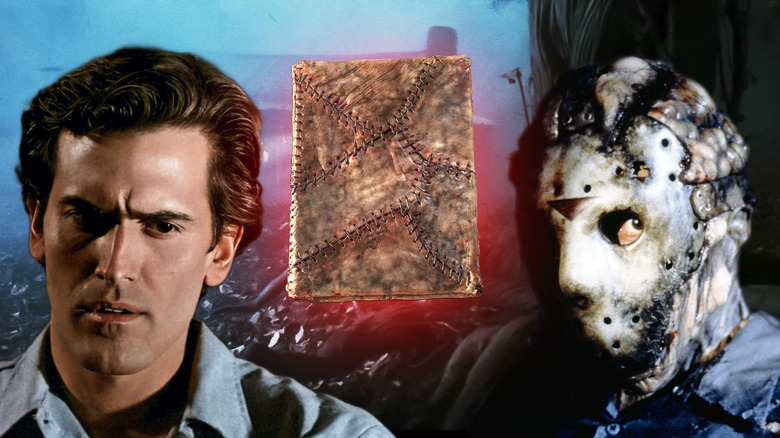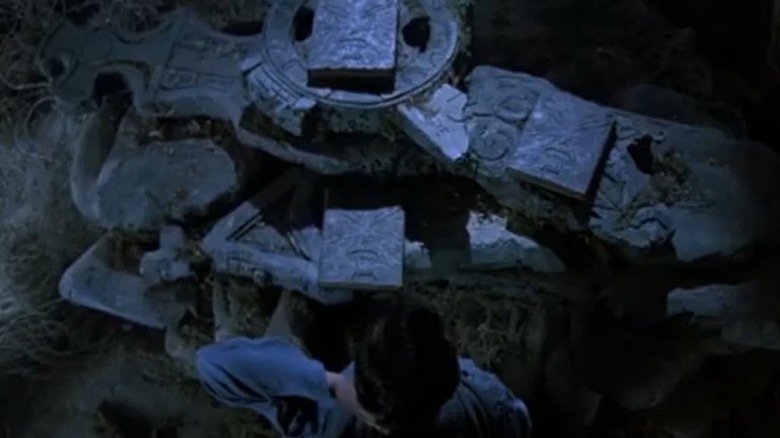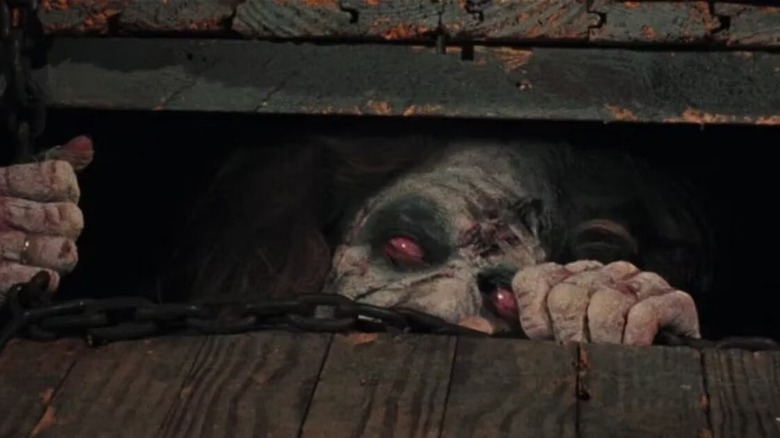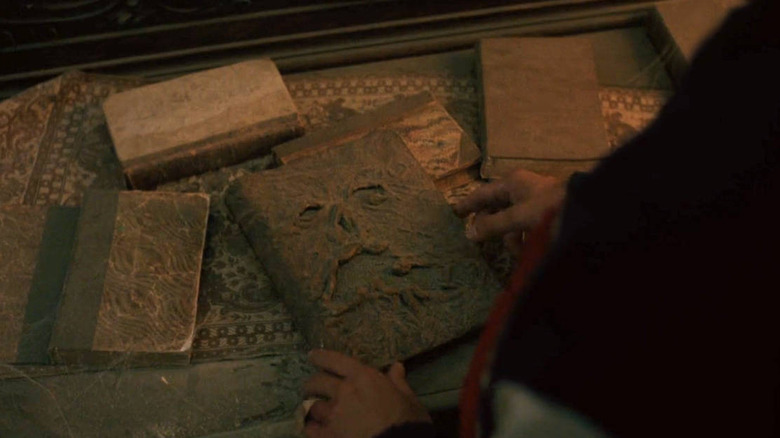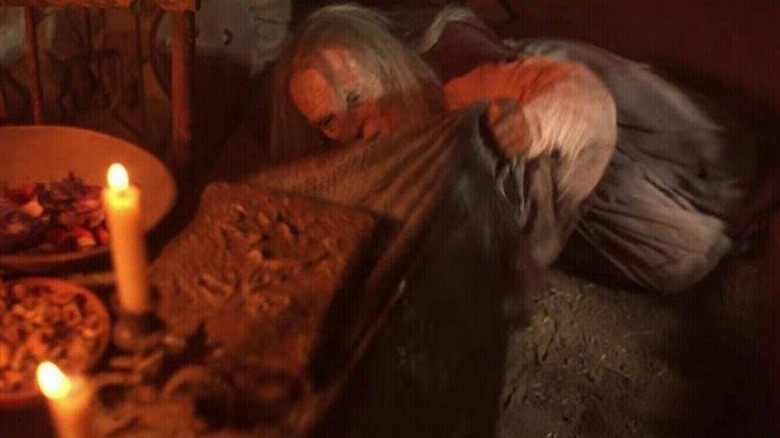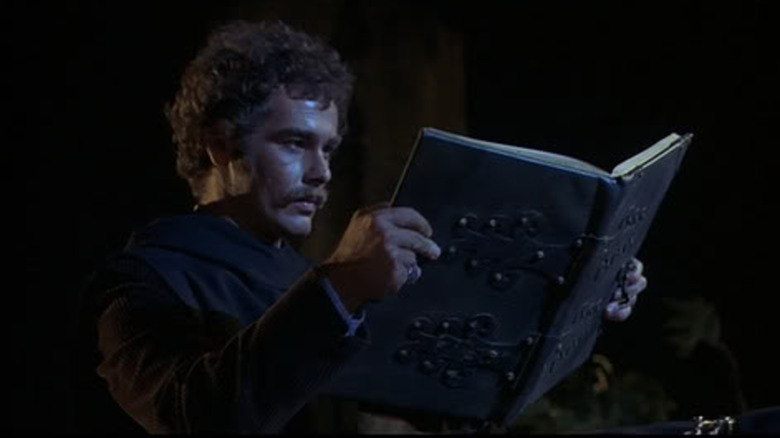Evil Dead Theory - Every Necronomicon Movie Takes Place In The Same Universe (Even Jason Goes To Hell)
H.P. Lovecraft is arguably the most influential author in the realm of fantastical fiction. Often hailed as the king of cosmic horror, his stories center around otherworldly concepts such as the Cthulhu Mythos — a shared universe comprised of Great Old Ones, powerful deities, and benevolent beings that we mere mortals can't comprehend. Furthermore, Lovecraft's stories frequently reference a book that's become known as the Necronomicon, a text that boasts secrets about the universe's most frightening and unfathomable concepts.
The Necronomicon has become so famous that many people believe Lovecraft's fictional text is a real grimoire, similar to "The Lesser Key of Solomon" and other occult tomes. Naturally, many cinematic adaptations of Lovecraft's work – "The Dunwich Horror," "Necronomicon: Book of the Dead," "Color Out of Space," etc. — have made the book a key part of their stories and further boosted its reputation in pop culture circles.
However, Lovecraft adaptations aren't the only movies to feature the Necronomicon. It's the heart of the horror in Sam Raimi's "Evil Dead" franchise, as well as the reboot movies. Not keen to repeat what came before, though, the "Evil Dead" creators brought their own ideas to the table when creating their Deadite grimoire, some of which have crept into seemingly unrelated horror movies throughout the years.
Since then, a variety of creatives have reimagined the Necronomicon for their own purposes, that doesn't mean all of these movies and stories can't co-exist in the same universe — in fact, we're here to argue that they do. So, without further ado, let's dive into these worlds of forbidden knowledge and find the connective tissues that bring every Necronomicon movie together.
The Evil Dead vs. H.P. Lovecraft
Before we establish the grandiose connection between every movie involving a Necronomicon, let's get the specifics out of the way first. There are some key differences between the "Evil Dead" and H.P. Lovecraft versions of the horrific tome, but they are both concerned with arcane knowledge, spells, incantations, and otherworldly forces.
The "Evil Dead" saga boasts at least three versions of the Necronomicon, all of which are made from human flesh, inked in blood, and written in the Sumerian language. These books were created by ancient beings known as the Dark Ones to mess with humans. They also have sentient abilities and have been known to bite and suck unfortunate souls into their pages (as poor Ash Williams found out in "Army of Darkness"). The books contain the power to open portals, travel to different time periods and dimensions, as well as summon demons known as Deadites, who can possess everything from human beings to trees to household appliances.
Lovecraft's grimoire can also summon gruesome monsters, but they're less hellish in nature. Lovecraft's creatures are more alien and tend to drive people mad, as opposed to stabbing pencils through them. This Necronomicon was originally written in Arabic text by a man named Abdul Alhazred, who resided in Yemen and was believed to have worshipped Lovecraftian deities such as Cthulhu. The text was subsequently translated into other languages, enabling various cultures to contact these mysterious creatures and god-like beings.
That said, while there are notable differences between the "Evil Dead" and Lovecraftian versions of the Necronomicon, that doesn't mean they aren't related.
Evil Dead is an expansion of Lovecraft's shared universe concept
H.P. Lovecraft never claimed that the Necronomicon depicted in his stories was the only forbidden text out there. For example, the Book of Eibon — the ancient grimoire that was created by Clark Ashton Smith for his fantasy stories — crops up in a few Lovecraft tales. Furthermore, some of Smith's most notable stories, such as "The Return of the Sorcerer," make mention of the Necronomicon and establish the idea of a myriad of evil texts co-existing alongside each other.
Now, this can be interpreted as some blatant cross-promotion between 20th-century pulp authors trying to make a buck and support each other. Or maybe — just maybe — the Necronomicon and Book of Eibon are part of the same world, which has since been expanded to include the sentient books that fuel the horror in the "Evil Dead" franchise. Do you need more convincing? No problem. In the "Evil Dead: Hail to the King" video game, Ash gets sent to Damascus and meets Abdul Alzeez, a "mad poet" who acquired ancient texts written by the Dark Ones. He isn't Abdul Alhazred per se, but they both hang out on the same continent, penning forbidden texts that wield the power to summon occult forces.
At the very least, the "Evil Dead" franchise is an expansion of the occultist mythos introduced by Lovecraft, Smith, and their peers all those years ago. However, it isn't the only horror franchise that exists in the same universe.
The Necronomicon connects Evil Dead and Friday the 13th
Did you know that Jason Voorhees is a Deadite?
In "Jason Goes to Hell: The Final Friday," the iconic slasher villain spends most of the movie making out with people so that he can possess them and continue his killing spree. Plus, Jason is just generally impossible to put down for good, and that's because he's one of the Evil Dead. "Jason Goes to Hell" confirms this theory, during a scene that takes place in the old Voorhees house. Steven (John D. LeMay) discovers the Necronomicon when he visits the dilapidated building about halfway through the movie, essentially confirming that it belonged to Jason's mom at some point. The movie never delves further than that, but fans have discussed it for years.
This theory has been confirmed by the filmmakers, as well. In an interview with Horror Geek Life, director Adam Marcus assured readers that Jason is a Deadite, and that explains why he is the way he is. He said that Pamela Voorhees made a deal with the devil to bring her son back from the dead by reading from the Necronomicon, and this explains why Jason has undergone so many iterations. To be fair, it's as good a reason as any for explaining the machete enthusiast's numerous resurrections throughout the course of this wacky franchise.
Jason's connection to the "Evil Dead" franchise means that Freddy Krueger is also part of this universe. This idea would have been explored on the screen if the once-planned "Freddy vs. Jason vs. Ash" movie ever came to fruition, but the comic book miniseries of the same name did delve into it, at least.
Pumpkinhead is also part of the Necronomicon universe
The director of "Jason Goes to Hell" has been open about the connection between "Friday the 13th" and "Evil Dead." That said, some filmmakers haven't revealed why their movies boast overt Necronomicon sightings. "Pumpkinhead II: Blood Wings" — a sequel to Stan Winston's 1988 masterpiece about a vengeance demon that slaughters bozo teenagers — features an appearance from the dreaded book, confirming that the "Pumpkinhead" franchise is in on the complex cosmic chaos.
In this one, some misguided teenagers find a page from the Necronomicon in a witch's house and use it to bring a murdered boy back from the dead, albeit as a hideous supernatural monster. After burning down the house, they resurrect the dead guy as the titular demonic entity and pay for their mistake later on. The witch in "Pumpkinhead II" is a guardian of the book and she does her best to prevent it from falling into the wrong hands, but her attempts are futile in the end.
Pumpkinhead isn't like the other creatures who've been summoned using the "Evil Dead" version of the Necronomicon. He really only punishes those who deserve to be slain for their transgressions. This philosophy isn't exactly consistent with the menacing mantra of the Dark Ones and their Deadite cronies, but Pumpkinhead has spilled enough blood to be Necronomicon-worthy all the same. These books just love inspiring people to make mistakes and unleash monsters, so they probably enjoyed watching Pumpkinhead's exploits in this underrated gem.
Finding the synergy between Lovecraft, Evil Dead, Friday the 13th, and Pumpkinhead
H.P. Lovecraft and some of his contemporaries established a shared universe of ghastly grimoires. By doing so, they invited other creators of fantastical scares to introduce their own forbidden texts and expand upon their esoteric visions. However, surely there must be some more focused connection that brings all of these cosmic ideas together in a more concise way, right?
The most obvious answer is that the Dark Ones and some deities from the Lovecraft universe have been in cahoots the entire time — and the complex scheming has one god's fingerprints all over it. Nyarlathotep, one of the Outer Gods in Lovecraft's oeuvre, is one of the few deities from the writers' works who frequently walks the Earth in the guise of one of us. He views humans as playthings and conspires with other gods, cults, and creatures to mess with people. He certainly shares the Dark Ones' penchant for chaos, so it makes sense that he'd seek out other ancient beings and unite all of these cosmic worlds.
Nyarlathotep is the most likely bridge between the Lovecraftian mythos and the Raimi universe, but he'll never admit it. He exists in the shadows, pulling the strings and laughing as the world burns. Still, we should thank him for bringing all of these great fantastical universes together, and for making horror cinema more interesting as a result. All hail Nyarlathotep!
